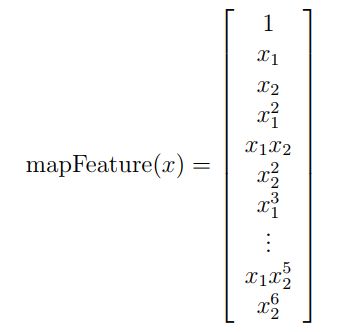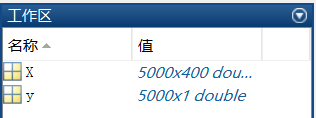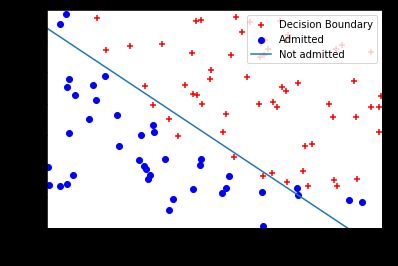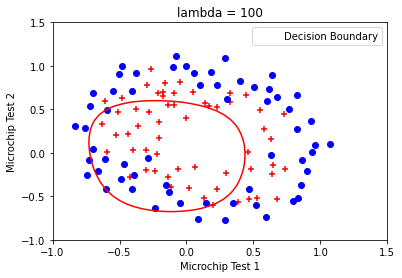吴恩达ML WEEK5 练习二(逻辑回归)+神经网络表示+练习三(多分类)
吴恩达机器学习 第五周
- 0 总结
- 1 练习二:逻辑回归
-
- 1.1 逻辑回归
-
- 1.1.1 可视化数据
- 1.1.2 sigmoid函数
- 1.1.3 代价函数和梯度
- 1.1.3 fmin_bfgs优化函数
- 1.1.4 评估逻辑回归
- 1.2 正则化的逻辑回归
-
- 1.2.1 数据可视化
- 1.2.2 特征映射(!重要)
- 1.2.3 代价函数的梯度
- 1.2.4 决策边界
- 2 神经网络的表示
-
- 2.1 神经网络假设函数
- 2.2 前向传播
- 2.3 神经网络应用举例
- 2.4 同或门
- 2.5 多分类问题
- 3 练习三:多分类问题和神经网络
-
- 3.1 多分类问题
-
- 3.1.1 数据可视化
- 3.1.2 逻辑回归向量化
- 3.1.3 多分类问题
- 3.1.4 多分类预测
0 总结
学习时间:2022.10.3~2022.10.9
- 完成练习二:逻辑回归及逻辑回归的正则化代码编写
- 学习神经网络的假设函数和前向传播的表示
- 学习如何使用神经网络解决多分类问题
- 完成练习三:逻辑回归多分类部分
1 练习二:逻辑回归
1.1 逻辑回归
==背景:==假设你是一个大学系的管理员,你需要根据每个申请人的两次考试的结果决定录取机会。
1.1.1 可视化数据
任务:完成plotData.py,画出figure1,横轴和纵轴是两个考试分数,正和负样本用不同符号表示。
代码:参考链接: python绘制散点图
def plot_data(X, y):
plt.figure()
# ===================== Your Code Here =====================
# Instructions : Plot the positive and negative examples on a
# 2D plot, using the marker="+" for the positive
# examples and marker="o" for the negative examples
#
# 分离正负样本
positive = X[y==1]
negative = X[y==0]
plt.scatter(positive[:,0],positive[:,1],marker='+',c='red',label='Admitted') #画出正样本
plt.scatter(negative[:,0],negative[:,1],marker='o',c='blue',label='Not Admitted') #画出正样本
1.1.2 sigmoid函数
tips:np.r_是按列连接两个矩阵,就是把两矩阵上下相加,要求列数相等。
np.c_是按行连接两个矩阵,就是把两矩阵左右相加,要求行数相等。
sigmoid函数:
g ( z ) = 1 1 + e − z g(z)=\frac{1}{1+e^{-z}} g(z)=1+e−z1
任务:完成sigmoid函数
代码:
def sigmoid(z):
# 初始化
g = np.zeros(z.size)
# ===================== Your Code Here =====================
# Instructions : Compute the sigmoid of each value of z (z can be a matrix,
# vector or scalar
#
# Hint : Do not import math
g = 1/(1+np.exp(-z))
return g
1.1.3 代价函数和梯度
tips: h θ ( x ) = 1 1 + e − θ T x h_\theta(x)=\frac{1}{1+e^{-\theta^Tx}} hθ(x)=1+e−θTx1 J ( θ ) = 1 m ∑ i = 1 m C o s t ( h θ ( x ( i ) ) , y ( i ) ) J(\theta)=\frac{1}{m}\sum_{i=1}^mCost(h_\theta(x^{(i)}),y^{(i)}) J(θ)=m1i=1∑mCost(hθ(x(i)),y(i))其中:
C o s t ( h θ ( x ) , y ) = − y l o g ( h θ ( x ) ) − ( 1 − y ) l o g ( 1 − h θ ( x ) ) Cost(h_\theta(x),y)=-ylog(h_\theta(x))-(1-y)log(1-h_\theta(x)) Cost(hθ(x),y)=−ylog(hθ(x))−(1−y)log(1−hθ(x))注意: y = 0 y=0 y=0或者 y = 1 y=1 y=1。
所以,代价函数:
J ( θ ) = 1 m ∑ i = 1 m C o s t ( h θ ( x ( i ) ) , y ( i ) ) = − 1 m [ ∑ i = 1 m y ( i ) l o g ( h θ ( x ( i ) ) ) + ( 1 − y ( i ) ) l o g ( 1 − h θ ( x ( i ) ) ) ] \begin{align} J(\theta) & = \frac{1}{m}\sum_{i=1}^mCost(h_\theta(x^{(i)}),y^{(i)}) \notag\\ & = -\frac{1}{m}[\sum_{i=1}^m y^{(i)} log(h_\theta(x^{(i)}))+(1-y^{(i)} )log(1-h_\theta(x^{(i)} ))]\notag \end{align} J(θ)=m1i=1∑mCost(hθ(x(i)),y(i))=−m1[i=1∑my(i)log(hθ(x(i)))+(1−y(i))log(1−hθ(x(i)))]当前要做的是:寻找合适的参数 θ \theta θ使得 J ( θ ) J(\theta) J(θ)最小;找到 θ \theta θ后,在给定某个输入 x x x可以预测出 h θ ( x ) h_\theta(x) hθ(x)。
作法:
Repeat{
θ j : = θ j − α ∂ J ( θ ) ∂ θ j : = θ j − α ∑ i = 1 m ( h θ ( x ( i ) ) − y ( i ) ) x j ( i ) \begin{align} \theta_j& :=\theta_j-\alpha\frac{\partial J(\theta)}{\partial \theta_j} \notag\\ & :=\theta_j-\alpha\sum_{i=1}^m(h_\theta(x^{(i)})-y^{(i)})x_j^{(i)}\notag \end{align} θj:=θj−α∂θj∂J(θ):=θj−αi=1∑m(hθ(x(i))−y(i))xj(i)}
任务:完成costFunction.py
注意:如果dot的两个参数是向量,则只要求他们的维度相等就可以直接dot。
代码:
def cost_function(theta, X, y):
m = y.size
# You need to return the following values correctly
cost = 0
# n+1
grad = np.zeros(theta.shape)
# ===================== Your Code Here =====================
# Instructions : Compute the cost of a particular choice of theta
# You should set cost and grad correctly.
#
# 计算cost和grad
# 假设函数h是m维向量
h = sigmoid(np.dot(X,theta))
#
term1 = -np.dot(y,np.log(h))
term2 = -np.dot(1-y,np.log(1-h))
cost = (term1 + term2)/m
grad = np.dot(h-y,X)/m
# ===========================================================
return cost, grad
1.1.3 fmin_bfgs优化函数
代码:
'''
fmin_bfgs优化函数
第一个参数是计算代价的函数
第二个参数是计算梯度的函数
参数x0传入初始化的theta值
maxiter设置最大迭代优化次数
'''
theta, cost, *unused = opt.fmin_bfgs(f=cost_func, fprime=grad_func, x0=initial_theta, maxiter=400, full_output=True, disp=False)
1.1.4 评估逻辑回归
任务:完成predict.py,输入48和45,会得到录取概率为0.776。
代码:
def predict(theta, X):
m = X.shape[0]
# Return the following variable correctly
p = np.zeros(m)
# ===================== Your Code Here =====================
# Instructions : Complete the following code to make predictions using
# your learned logistic regression parameters.
# You should set p to a 1D-array of 0's and 1's
#
p = sigmoid(X.dot(theta))
p[p>=0.5] = 1
p[p<0.5] = 0
# ===========================================================
return p
1.2 正则化的逻辑回归
1.2.1 数据可视化

数据没有被直线分割成正和负两部分,因此线性的逻辑回归并不能很好地分割这部分数据集。
1.2.2 特征映射(!重要)
一个更好地拟合数据的方法是创造更多的特征。在mapFeauture.py中,我们将两个特征映射成x1、x2的六次方的特征多项式。

这样我们就将两个特征变成28位的向量。在这组高纬度的特征向量训练出来的逻辑回归分类器,将有更复杂的决策边界和非线性。但是,也可能会出现过拟合问题,因此我们需要对逻辑回归进行正则化。
1.2.3 代价函数的梯度
任务:完成costFunctionReg.py
注意:python下标从0开始,如图所示:

代码:
def cost_function_reg(theta, X, y, lmd):
m = y.size
# You need to return the following values correctly
cost = 0
grad = np.zeros(theta.shape)
# ===================== Your Code Here =====================
# Instructions : Compute the cost of a particular choice of theta
# You should set cost and grad correctly.
#
# h:(m,1)
h = sigmoid(X.dot(theta))
m1 = -y.dot(np.log(h))
m2 = -(1-y).dot(np.log(1-h))
m3 = theta[1:].dot(theta[1:])
cost = (m1+m2)/m + lmd*m3/(2*m)
grad = X.T.dot(h-y)/m
grad[1:] += theta[1:]*lmd/m
# ===========================================================
return cost, grad
1.2.4 决策边界
任务:使用fmin_bfgs训练参数 θ \theta θ,并绘制决策边界。使用不同的KaTeX parse error: Undefined control sequence: \ambda at position 1: \̲a̲m̲b̲d̲a̲,观察决策边界的变化。
结果:

2 神经网络的表示
2.1 神经网络假设函数
输入为 x 0 , x 1 , x 2 , x 3 x_0,x_1,x_2,x_3 x0,x1,x2,x3, x 0 x_0 x0为偏差单元,有时候不写,永远为1。
激励函数为sigmoid函数。
假设函数为 h θ ( x ) = 1 1 + e − z h_\theta(x)=\frac{1}{1+e^{-z}} hθ(x)=1+e−z1
权重为θ \theta θ
Layer1:输入层,Layer2:隐藏层(可不止一层),Layer3:输出层。
a i j a_i^j aij:第 j j j层的第 i i i个激活项。(上角标表示层数)
Θ j \Theta^j Θj:第 j j j层到第 j + 1 j+1 j+1层的权重。
如果神经网络在第 j j j层有 s j s_j sj个单元,在第 j + 1 j+1 j+1层有 s j + 1 s_{j+1} sj+1个单元,那么 Θ j = s j + 1 × ( s j + 1 ) \Theta_j=s_{j+1}\times(s_j+1) Θj=sj+1×(sj+1)(不包含1),比如这里, Θ 1 ∈ R 3 × 4 \Theta_1\in\mathbb{R}^{3\times4} Θ1∈R3×4
2.2 前向传播

如图,假设输入: x = a ( 1 ) = [ x 0 x 1 x 2 x 3 ] ∈ R 4 x=a^{(1)}=\begin{bmatrix} x_0 \\ x_1 \\ x_2 \\ x_3 \end{bmatrix}\in\mathbb{R}^4 x=a(1)=⎣ ⎡x0x1x2x3⎦ ⎤∈R4,其中 x 0 = 1 x_0 = 1 x0=1。那么,定义: z ( 2 ) = [ z 1 ( 2 ) z 2 ( 2 ) z 3 ( 2 ) ] = [ Θ 10 ( 1 ) x 0 + Θ 11 ( 1 ) x 1 + Θ 12 ( 1 ) x 2 + Θ 13 ( 1 ) x 3 Θ 20 ( 1 ) x 0 + Θ 21 ( 1 ) x 1 + Θ 22 ( 1 ) x 2 + Θ 23 ( 1 ) x 3 Θ 30 ( 1 ) x 0 + Θ 31 ( 1 ) x 1 + Θ 32 ( 1 ) x 2 + Θ 33 ( 1 ) x 3 ] = Θ ( 1 ) a ( 1 ) ∈ R 3 z^{(2)}=\begin{bmatrix} z^{(2)}_1 \\ z^{(2)}_2 \\ z^{(2)}_3 \end{bmatrix} = \begin{bmatrix} \Theta^{(1)}_{10}x_0+\Theta^{(1)}_{11}x_1+\Theta^{(1)}_{12}x_2+\Theta^{(1)}_{13}x_3\\ \Theta^{(1)}_{20}x_0+\Theta^{(1)}_{21}x_1+\Theta^{(1)}_{22}x_2+\Theta^{(1)}_{23}x_3\\ \Theta^{(1)}_{30}x_0+\Theta^{(1)}_{31}x_1+\Theta^{(1)}_{32}x_2+\Theta^{(1)}_{33}x_3 \end{bmatrix} = \Theta^{(1)}a^{(1)} \in\mathbb{R}^3 z(2)=⎣ ⎡z1(2)z2(2)z3(2)⎦ ⎤=⎣ ⎡Θ10(1)x0+Θ11(1)x1+Θ12(1)x2+Θ13(1)x3Θ20(1)x0+Θ21(1)x1+Θ22(1)x2+Θ23(1)x3Θ30(1)x0+Θ31(1)x1+Θ32(1)x2+Θ33(1)x3⎦ ⎤=Θ(1)a(1)∈R3,理解到矩阵中每一行是该层某个神经元的计算公式。那么: a ( 2 ) = g ( z ( 2 ) ) ∈ R 3 a^{(2)}=g(z^{(2)})\in\mathbb{R}^3 a(2)=g(z(2))∈R3,其中, g g g为sigmoid函数。至此,第二层三个神经元的值计算出来了。
将 a 0 ( 2 ) = 1 a^{(2)}_0=1 a0(2)=1加入到矩阵 a ( 2 ) a^{(2)} a(2)中, a ( 2 ) a^{(2)} a(2)变为四维向量。
重复上述步骤: z ( 3 ) = Θ ( 2 ) a ( 2 ) , z^{(3)}=\Theta^{(2)}a^{(2)}, z(3)=Θ(2)a(2), h Θ ( x ) = a ( 3 ) = g ( z ( 3 ) ) h_\Theta(x)=a^{(3)}=g(z^{(3)}) hΘ(x)=a(3)=g(z(3))。
2.3 神经网络应用举例
逻辑与

可以看到,当 Θ = [ − 30 20 20 ] \Theta=\begin{bmatrix} -30 \\ 20 \\ 20 \end{bmatrix} Θ=⎣ ⎡−302020⎦ ⎤的时候,这个神经网络可以模拟逻辑与。
逻辑或

可以看到,当 Θ = [ − 10 20 20 ] \Theta=\begin{bmatrix} -10 \\ 20 \\ 20 \end{bmatrix} Θ=⎣ ⎡−102020⎦ ⎤的时候,这个神经网络可以模拟逻辑或。
2.4 同或门
利用之前设计的神经网络设计一个同或门。
(!看清楚颜色对应)

2.5 多分类问题
3 练习三:多分类问题和神经网络
3.1 多分类问题
data = scio.loadmat('ex3data1.mat')
X = data['X']
y = data['y'].flatten()
ex3data1.mat中数据:
一共有5000个样本,每个样本是20x20像素的图像。每个像素使用浮点数表示灰度。y是1-10的数字。现在需要使用逻辑回归和神经网络识别手写数字0~9。

3.1.1 数据可视化
3.1.2 逻辑回归向量化
代价函数
在没有正则化的逻辑回归中,代价函数的表达式:

因此我们需要先计算 h θ ( x ( i ) ) h_\theta(x^{(i)}) hθ(x(i)),假设函数表达式如下:

因此我们定义:

m m m:样本个数。
x ( i ) x^{(i)} x(i):第 i i i个样本的n+1个数据,是列向量。
如果 a a a和 b b b是向量,则 a T b a^Tb aTb= b T a b^Ta bTa
梯度
在没有正则化的逻辑回归中,梯度的表达式:

将每一步的偏导写出:

任务:完成lrCostFunctio.py
代码:(正则化)
def compute_cost(theta,X,y,lmd):
cost = 0
m = y.size
h = sigmoid(X.dot(theta))
temp1 = -np.dot(y.T,np.log(h))
temp2 = -np.dot((1-y).T,np.log(1-h))
temp3 = np.dot(theta[1:].T,theta[1:])
cost = (temp1+temp2)/m+temp3*lmd/(2*m)
return cost
def compute_grad(theta,X,y,lmd):
m = y.size
grad = np.zeros(theta.shape)
h = sigmoid(X.dot(theta))
temp4 = h-y
grad = np.dot(X.T, temp4)/m
grad[1:] += theta[1:]*lmd/m
return grad
def lr_cost_function(theta, X, y, lmd):
cost = compute_cost(theta, X, y, lmd)
grad = compute_grad(theta, X, y, lmd)
return cost, grad
3.1.3 多分类问题
在多分类问题中,参数矩阵 Θ ∈ R K × ( N + 1 ) \Theta \in \mathbb{R}^{K\times(N+1)} Θ∈RK×(N+1),K为分类的类别个数,也就是说,每一行表示了每一类的参数。在手写识别问题中, K = 10 K=10 K=10,注意到 y = 10 y=10 y=10的时候,表示手写图片是0。
任务:完成oneVsAll.py
代码:
def one_vs_all(X, y, num_labels, lmd):
# Some useful variables
(m, n) = X.shape
# You need to return the following variables correctly
all_theta = np.zeros((num_labels, n + 1))
initial_theta = np.zeros(n+1)
# Add ones to the X data 2D-array
X = np.c_[np.ones(m), X]
# 循环:每一类进行一次循环
# i = 0,1,2,...num_labels-1
for i in range(num_labels):
print('Optimizing for handwritten number {}...'.format(i))
# ===================== Your Code Here =====================
# Instructions : You should complete the following code to train num_labels
# logistic regression classifiers with regularization
# parameter lambda
#
#
# Hint: you can use y == c to obtain a vector of True(1)'s and False(0)'s that tell you
# whether the ground truth is true/false for this class
#
# Note: For this assignment, we recommend using opt.fmin_cg to optimize the cost
# function. It is okay to use a for-loop (for c in range(num_labels) to
# loop over the different classes
#
# 手写数字0的时候y=10
iclass = i if i else 10
y_temp = np.array([1 if iy == iclass else 0 for iy in y ])
''' fmin_cg优化函数 第一个参数是计算代价的函数 第二个参数是计算梯度的函数 参数x0传入初始化的theta值
args传入训练样本的输入特征矩阵X,对应的2分类新标签y,正则化惩罚项系数lmd
maxiter设置最大迭代优化次数
'''
res = opt.fmin_cg(lCF.compute_cost,fprime = lCF.compute_grad,x0 = initial_theta,\
args=(X,y_temp,lmd),maxiter=50,disp=False,full_output=True)
all_theta[i] = res[0]
# ============================================================
print('Done')
return all_theta
3.1.4 多分类预测
任务:完成predictOneVsAll.py
tips: argmax的用法
代码:
def predict_one_vs_all(all_theta, X):
m = X.shape[0]
num_labels = all_theta.shape[0]
# You need to return the following variable correctly;
p = np.zeros(m)
# Add ones to the X data matrix
X = np.c_[np.ones(m), X]
# ===================== Your Code Here =====================
# Instructions : Complete the following code to make predictions using
# your learned logistic regression parameters (one vs all).
# You should set p to a vector of predictions (from 1 to
# num_labels)
#
# Hint : This code can be done all vectorized using the max function
# In particular, the max function can also return the index of the
# max element, for more information see 'np.argmax' function.
#
poss = sigmoid(X.dot(all_theta.T))
# 每一行最大值的下标
index_max = np.argmax(poss,axis = 1)
p = np.array([index if index else 10 for index in index_max])
return p












